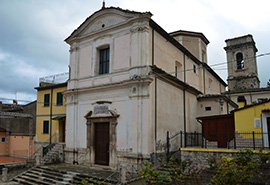In 1216 St. Francis, on his way to Castelvecchio Subequo, passed Palena and was a guest of the Earl Thomas Vinciguerra. According to legends he laid the foundation stone of a large convent. He chose as usual, a site where there already existed a smaller, older church called Santa Maria.
Completed by 1308 the church enjoyed nearly three centuries of life. Around 1635 the franciscan community was suppressed and passed to the brotherhood of the suffrage.
The 1706 earthquake that struck Palena hard, also damaged this church, which was promptly restored, thanks to the wide availability of the brotherhood, obliterating the ancient medieval aspect. The floorplan remained unchanged for a single aisled church, but the austerity of the building in franciscan style was altered to new complex and articulated plasterwork decorations and paintings.
The building with a sole hall presents a transet that juts out and covered with a vaulted ceiling. The four altars at the sides are framed with decorative plaster work which allows the nominated statues to stand out.
On the main altar, two statues depicting King Solomon and David, are placed on either side of the altarpiece by Girolamo Cenatiempo (news 1700-1744). On it a depiction of the Madonna and Child with St. Francis above it a cameo in plaster showing the episode of ecstasy of St. Francis, above which stands the emblem in wood of the confraternity.
The area of the sanctuary is illuminated by the light descending from the dome decorated with a fake architecture, based on four pendentives decorated with figures of the four doctors of the church. On the sides of presbytery there are two block altars with a broken entablature, surmounted by a rich base, the ends of each of the two windows are painted with personifications of Virtues.
On the vault of the aisle above the entrance a painting of a flurry of angels ascending to heaven while the other scenes depicted are on the flight into Egypt, the Death of the Virgin and a Miracle of Jesus.
Around the XIX century the franciscan monastery, now empty for at least a century, ceases to exist and is incorporated in the residence belonging to the Recchione family which was razed to the ground during the Second World War.

In 1216 St. Francis, on his way to Castelvecchio Subequo, passed Palena and was a guest of the Earl Thomas Vinciguerra. According to legends he laid the foundation stone of a large convent. He chose as usual, a site where there already existed a smaller, older church called Santa Maria.
Completed by 1308 the church enjoyed nearly three centuries of life. Around 1635 the franciscan community was suppressed and passed to the brotherhood of the suffrage.
The 1706 earthquake that struck Palena hard, also damaged this church, which was promptly restored, thanks to the wide availability of the brotherhood, obliterating the ancient medieval aspect. The floorplan remained unchanged for a single aisled church, but the austerity of the building in franciscan style was altered to new complex and articulated plasterwork decorations and paintings.
The building with a sole hall presents a transet that juts out and covered with a vaulted ceiling. The four altars at the sides are framed with decorative plaster work which allows the nominated statues to stand out.
On the main altar, two statues depicting King Solomon and David, are placed on either side of the altarpiece by Girolamo Cenatiempo (news 1700-1744). On it a depiction of the Madonna and Child with St. Francis above it a cameo in plaster showing the episode of ecstasy of St. Francis, above which stands the emblem in wood of the confraternity.
The area of the sanctuary is illuminated by the light descending from the dome decorated with a fake architecture, based on four pendentives decorated with figures of the four doctors of the church. On the sides of presbytery there are two block altars with a broken entablature, surmounted by a rich base, the ends of each of the two windows are painted with personifications of Virtues.
On the vault of the aisle above the entrance a painting of a flurry of angels ascending to heaven while the other scenes depicted are on the flight into Egypt, the Death of the Virgin and a Miracle of Jesus.
Around the XIX century the franciscan monastery, now empty for at least a century, ceases to exist and is incorporated in the residence belonging to the Recchione family which was razed to the ground during the Second World War.













